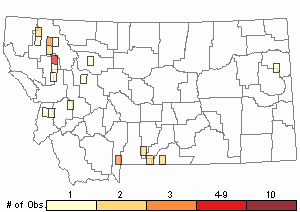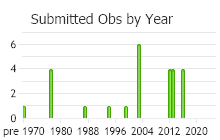View in other NatureServe Network Field Guides
NatureServe
Montana
Utah
Wyoming
Idaho
Wisconsin
British Columbia
South Carolina
Yukon
California
New York
Lingberg's Hypnum Moss - Hypnum lindbergii
Other Names:
Seepy Fern Moss
General Description
Plants: Pleurocarpous (Vitt 1988), typically growing in soft and somewhat open (Crum and Anderson et al. 1981) interwoven mats or occasionally in more upright tufts (Lawton 1971), green with gold or yellowish tones, or light green. Stems nearly upright to prostrate, freely to few-branched, occasionally slightly pinnate, 1-5 cm, russet to green with yellow tones, turning brown with time; branches 2-20 mm in length; hyalodermis and well-formed central strand present; pseudoparaphyllia leafy; rhizoids absent or few (FNA 2014); cortical stem cells big and somewhat transparent (Lawton 1971).
Stem Leaves: Loosely arranged, spreading to about 45 degrees, the tips curved in sickle-like fashion and turned in one direction (Crum and Anderson et al. 1981), occasionally only slightly so (FNA 2014) to straight, the leaves differing on a given plant (Lawton 1971), 0.5-2 mm in length, to 1 mm in width (FNA 2014), cupped (Lawton 1971), egg-shaped and somewhat oblong, slowly tapering to the acute leaf tip, the apex narrow-to-wide, the base extending down the stem (FNA 2014), frequently somewhat lobed (Crum and Anderson et al. 1981); leaf edges flat, smooth, or dully saw-toothed particularly apically; costa paired and short (FNA 2014), occasionally reaching to 1/3 the leaf length (Crum and Anderson et al. 1981); branch leaves akin to stem leaves (FNA 2014).
Leaf Cells: Laminal cells not papillose (FNA 2014), upper laminal cells somewhat long and very slender (Crum and Anderson et al. 1981); medial laminal cells longer and narrower than the basal cells (FNA 2014), the walls nonporose (Lawton 1971); basal laminal cells colored yellow and with pitted walls; alar cells inflated, thin-walled (FNA 2014), nearly transparent or pigmented (Lawton 1971), extending 2-4 rows up the leaf edge, the alar area clearly delineated (FNA 2014), with somewhat square cells in the area immediately above (Lawton 1971).
Phenology
Fruit ripens in late spring and summer (FNA 2014).
Diagnostic Characteristics
The similar Hypnum pratense is usually quite shiny and lacks distinctive alar cells. The alar area of Hypnum lindbergii, on the other hand, is well-delineated (FNA 2014).
Range Comments
North American Range
Canada: YT to NU, BC to NL and NS; USA: AK and most of the continental states (except in OR, ID, KS, IA, IN, KY, DE, LA, GA and FL) (FNA 2014). Known in Montana from Carbon, Flathead, Glacier, Gallatin, Lake, Lewis and Clark, Lincoln, and Stillwater Counties (Elliott and Pipp 2016).
Observations in Montana Natural Heritage Program Database
Number of Observations: 36
(Click on the following maps and charts to see full sized version)
Map Help and Descriptions
Relative Density

Recency



 (Observations spanning multiple months or years are excluded from time charts)
(Observations spanning multiple months or years are excluded from time charts)
Habitat
Wet soil and humus or decaying wood in swampy woods and open areas of sedges, also on the edges of lakes and watercourses (Crum and Anderson et al. 1981). Occurring from lowlands to about 9840 feet elevation (FNA 2014).
Reproductive Characteristics
Dioicous, sporophytes uncommon. Exterior perichaetial bracts bent back and downward; interior perichaetial bracts upright with an attenuate acumen (FNA 2014), pleats (Lawton 1971), saw-toothed edges distally, and a faint costa. Seta 25-40 mm tall, somewhat red, smooth. Capsule light brown, 2-3 mm in length (FNA 2014), strongly tilted to level (Crum and Anderson et al. 1981), ribbed when dry (FNA 2014), the ribs continuing along the short neck, bowed, shrunken below the opening when dry (Lawton 1971); operculum cone-shaped; exostome teeth 16, with a zigzag line on the outer face, fine lines or ridges below, and papillae above; endostome processes 16, similar in height as the teeth, keeled, cilia same height as endostome processes. Calyptra hairless and draping hood-like (FNA 2014).
Stewardship Responsibility
References
- Literature Cited AboveLegend:
 View Online Publication
View Online Publication Crum, H.A. and L.E. Anderson. 1981. Mosses of Eastern North America. 2 volumes. Columbia University Press, New York. 1328 pp.
Crum, H.A. and L.E. Anderson. 1981. Mosses of Eastern North America. 2 volumes. Columbia University Press, New York. 1328 pp. Elliott, J.C. and A.K. Pipp. 2018. A Checklist of Montana Mosses (1880-2018). Updated 3 January, 2020. Montana Natural Heritage Program, Helena, Montana. 73 pp.
Elliott, J.C. and A.K. Pipp. 2018. A Checklist of Montana Mosses (1880-2018). Updated 3 January, 2020. Montana Natural Heritage Program, Helena, Montana. 73 pp. Flora of North America Editorial Committee, eds. 2014. Flora of North America North of Mexico. Volume 28. Bryophytes: Mosses, Part 2. Oxford University Press, Inc., NY. xxi + 702 pp.
Flora of North America Editorial Committee, eds. 2014. Flora of North America North of Mexico. Volume 28. Bryophytes: Mosses, Part 2. Oxford University Press, Inc., NY. xxi + 702 pp. Lawton, E. 1971. Moss Flora of the Pacific Northwest. Hattori Botanical Laboratory. Japan: Yamabuki-cho, Shinjuku-ku, Tokyo. 362 pages plus appendices.
Lawton, E. 1971. Moss Flora of the Pacific Northwest. Hattori Botanical Laboratory. Japan: Yamabuki-cho, Shinjuku-ku, Tokyo. 362 pages plus appendices. Vitt, D. J. Marsh, and R. Bovey. 1988. Mosses, Lichens & Ferns of Northwest North America. Seattle, WA: University of Washington Press. 296 p.
Vitt, D. J. Marsh, and R. Bovey. 1988. Mosses, Lichens & Ferns of Northwest North America. Seattle, WA: University of Washington Press. 296 p.
- Additional ReferencesLegend:
 View Online Publication
View Online Publication
Do you know of a citation we're missing? Elliot, J. C. 1993. Second checklist of Montana mosses. Unpublished report. U.S. Forest Service, Region 1. Missoula, MT. 45 pp.
Elliot, J. C. 1993. Second checklist of Montana mosses. Unpublished report. U.S. Forest Service, Region 1. Missoula, MT. 45 pp. Flowers, S. 1973. Mosses: Utah and the West. Brigham Young University, Provo, Utah. 567 p.
Flowers, S. 1973. Mosses: Utah and the West. Brigham Young University, Provo, Utah. 567 p. Lawton, E. 1971. Keys for the Identification of the Mosses on the Pacific Northwest. Reprinted from 'Moss Flora of the Pacific Northwest'. Published as Supplement No. 2 of the Journal of the Hattori Botanical Laboratory. Nichinan, Miyazaki, Japan. 66 pp.
Lawton, E. 1971. Keys for the Identification of the Mosses on the Pacific Northwest. Reprinted from 'Moss Flora of the Pacific Northwest'. Published as Supplement No. 2 of the Journal of the Hattori Botanical Laboratory. Nichinan, Miyazaki, Japan. 66 pp. Malcolm, B., N. Malcolm, J. Shevock, and D. Norris. 2009. California Mosses. Nelson, New Zealand: Micro-Optics Press. 430 pp.
Malcolm, B., N. Malcolm, J. Shevock, and D. Norris. 2009. California Mosses. Nelson, New Zealand: Micro-Optics Press. 430 pp. Smith, A.J.E. 1980. The Moss Flora of Britain and Ireland. Cambridge University Press, Cambridge. 705 pp.
Smith, A.J.E. 1980. The Moss Flora of Britain and Ireland. Cambridge University Press, Cambridge. 705 pp.
- Web Search Engines for Articles on "Lingberg's Hypnum Moss"





